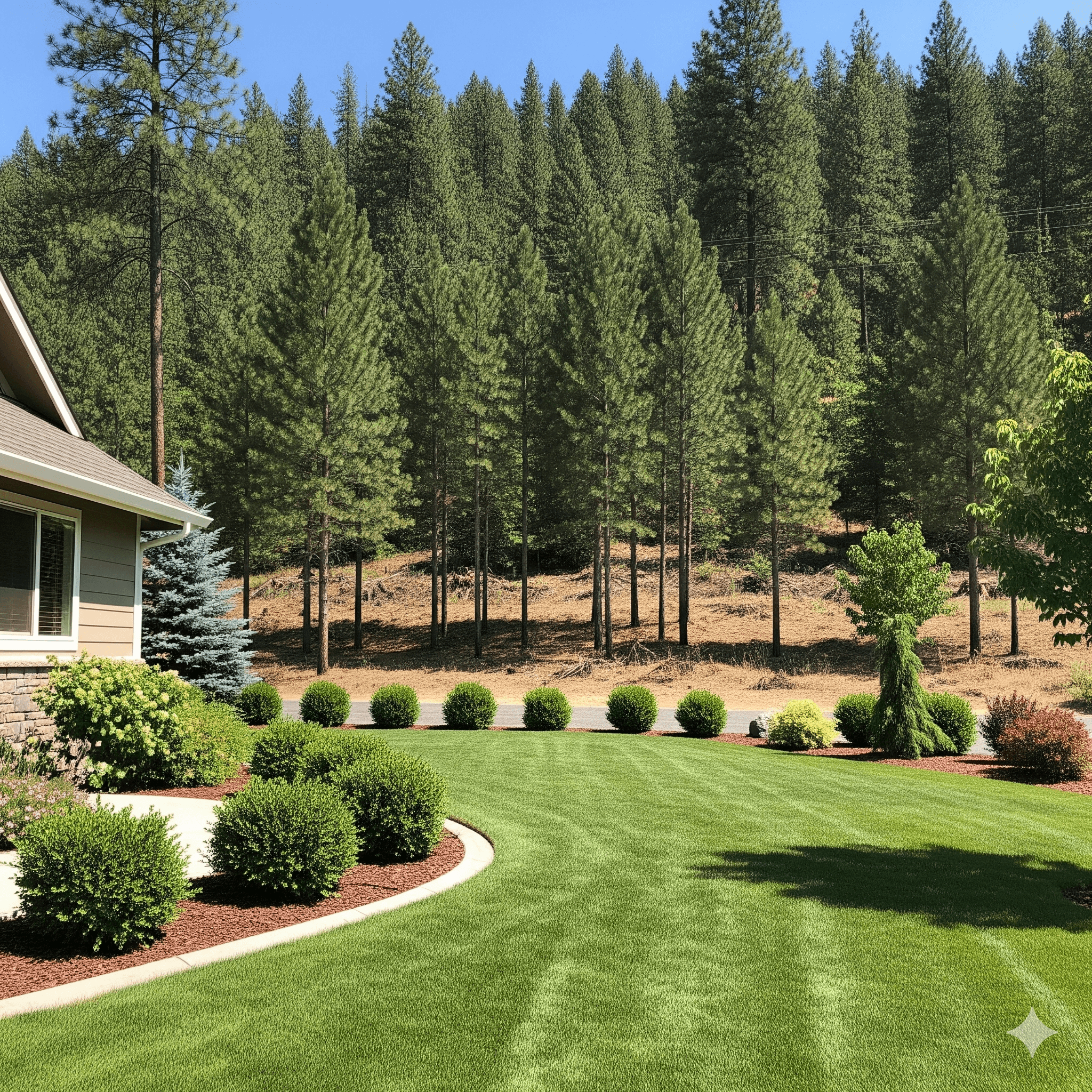Inland Northwest Wildfire Mitigation & Defensible Space Guide
A practical, science-grounded homeowner resource focused on Spokane, Green Bluff, Deer Park, Mead, Chattaroy, Liberty Lake, Newport and surrounding Inland Northwest parcels—how wildfire behaves, why ladder fuels amplify risk, and how professional forestry mulching accelerates fuel reduction and defensible space creation.
Looking for more educational content? Visit the Forestry Knowledge Hub for additional guidance & future updates.

1. Wildfire Behavior Starts with Fuel Arrangement
You cannot control drought, temperature or wind. You can control the fuel component of the fire triangle. On Inland Northwest mixed conifer & transitional parcels, combustible biomass spans fine flashy fuels (pine needles, dry grass), ladder fuels (tall brush, saplings, low limbs) and crown fuels (canopy foliage). Fire intensity and rate of spread correlate less with raw acreage than with continuity—the unbroken horizontal and vertical pathways that allow flame to progress and escalate.
The most dangerous transition on a private parcel is surface fire converting into a crown fire via ladder fuels. Breaking that vertical connectivity is the single highest leverage mitigation action a homeowner can implement or contract.
2. Defensible Space & The Home Ignition Zone (HIZ)
Research shows structural survival probability is dominated by the condition of the first 100–200 feet around improvements—not distant flame walls. Segmentation into Zones 0–2 provides a prioritized workload sequence. Focus meticulous manual upkeep in Zone 0, then leverage mechanized efficiency (forestry mulching) to accelerate Zones 1 & 2.
Zone 0 (0–5 ft)
Prevent ember ignition
- •Replace combustible mulch with gravel / pavers
- •Remove all leaves, needles & debris (ground, gutters, roof)
- •Relocate firewood, furniture, planters
- •Break combustible fence contact with structure
Zone 1 (5–30 ft)
Reduce radiant heat & stop direct flame
- •Remove dead vegetation & dry grass
- •Maintain 10 ft spacing between mature tree crowns
- •Prune lower limbs 6–10 ft (eliminate ladder fuels)
- •Group plants in irrigated islands (not continuous beds)
Zone 2 (30–100+ ft)
Interrupt fire spread & lower flame length
- •Mow annual grasses ≤ 4 inches
- •Thin saplings & dense shrub clumps for spacing
- •Remove heavy litter accumulations (retain ≤ 3 inches)
- •Isolate woodpiles w/ 10 ft mineral soil clearance
3. Why Forestry Mulching Is a Force Multiplier
Traditional manual reduction (chainsaw + drag + chip + haul) is multi-stage, high fatigue and slow. Dozing/excavation scrapes soil horizons, generates haul piles and triggers disposal logistics. Forestry mulching consolidates cutting, processing and distribution into a single controlled pass—shredding ladder fuels, thinning understory competition and laying an erosion-moderating mulch layer that retains moisture and suppresses regrowth.
Core Outcomes
- Rapid ladder fuel elimination prevents canopy transition
- Horizontal discontinuities convert dense thickets into spaced stems
- Mulch layer moderates soil moisture & reduces erosion velocity
- Reduced hauling, burning & permitting complexity
- Improves access lines for future maintenance & ingress/egress safety
Equipment Matters
- Purpose-built mulching carriers outperform generic light skid steer add-ons
- Drum heads = cleaner finish & safer throw near homes & fences
- Disc heads trade finish & debris control for raw felling speed
4. Mulching Head Comparison (What to Ask For)
Drum Mulcher
Best For: Fine residential finish, versatile fuel reduction
- Finish: Fine, uniform mulch
- Safety: Controlled downward throw (safer near structures)
Disc Mulcher
Best For: Fast felling in open rural tracts
- Finish: Coarse, larger chunks
- Safety: Greater lateral throw distance
For most residential wildfire mitigation & aesthetic goals across Spokane foothill parcels, a drum mulcher provides optimal balance of control, finish and risk reduction.
5. Time, Labor & Cost Reality
Hundreds of manual labor hours per acre are common when understory density, dragging distance and chip handling are included. A professional mulching setup can reduce that to a single digit hour footprint per treated acre under moderate fuel loads—compressing multi-week DIY trajectories into a single mobilization. True project value emerges not only from speed but from avoided hauling, disposal, burn permit acquisition, and post-doze site rehabilitation.
6. Beyond Fire: Soil & Landscape Upside
Unlike mass scraping, mulching preserves root networks, limits compaction and steadily recycles nutrients via decomposition. The moderated microclimate supports native drought-tolerant species establishment—reinforcing long-term resilience. Weed & invasive suppression improves when the mulch layer intercepts light on seed banks while maintaining infiltration.
7. Practical Hybrid Strategy (Homeowner + Pro)
- Homeowner: Maintain Zone 0 obsessively (debris removal, ember exclusion).
- Professional Mulching: Rapidly restructure Zones 1 & 2: ladder fuel elimination, spacing, selective thinning.
- Follow-Up: Light maintenance pass every 1–3 years guided by regrowth & wind exposure vectors.
8. Contractor Vetting Checklist
Ask these before hiring to ensure safety, quality & compliance with Inland Northwest defensible space priorities:
- ✔Are you licensed & insured for forestry / vegetation management?
- ✔What machine & mulching head (drum vs disc) will you use and why?
- ✔How will you treat Zones 0–2 differently to meet defensible space guidelines?
- ✔Will mulch depth be managed (avoid smothering > ~3–4 inches)?
- ✔Can you provide an itemized total cost (no hidden hauling / disposal)?
- ✔Do you offer follow-up or maintenance scheduling?
- ✔Can you share recent residential client references?
Ready to Accelerate Your Fuel Reduction?
We serve Spokane, Green Bluff, Deer Park, Mead, Chattaroy, Liberty Lake, Newman Lake, Elk, Diamond Lake, Newport & nearby communities. Transform overgrown acreage into resilient defensible space with professional forestry mulching.
Also explore our core services: Forestry Mulching | Defensible Space | Service Areas